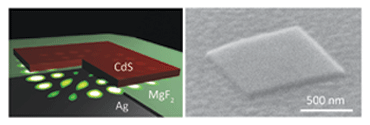Nanolasers just got a little toastier. No, we're not talking about the world's tiniest death rays. The surface plasmon lasers, or "spasers," that IEEE Spectrum described last year can generate visible light in a space only 5 nanometers wide. They seemed a promising step towards the age of optical computing, but the little guys had a serious flaw: The devices, which stimulate oscillating electrons near a metal's surface with electromagnetic waves, needed a frigid 10 Kelvin environment to keep the light from leaking out. In a paper, published on Sunday in Nature Materials, a University of California, Berkeley team reports that they've modified the laser so that it can now operate at room temperature.
According to a university press release, the research team led by Xiang Zhang, a mechanical engineering professor at UC, Berkeley, found the solution by redesigning the lasers to work a bit like whispering galleries. These often dome-shaped spaces (such as the one in New York City's Grand Central Station, pictured below) allow two people to utter secret messages across a room, as the sound waves reflect off the ceiling.
For their ceiling, Zhang's team used a 45 nanometer-thick cadmium sulfide patch--which captured the light in a 5-nanometer magnesium fluoride gap between a silver base and the cadmium sulfide.
The press release says the Berkeley scientists could then confine the light to 20 nanometers and forgo the cryogenics. According to Zhang, a room-temperature spaser nanolaser could lead to single-molecule biodetectors, photonic circuits, and high-speed optical communication systems. Renmin Ma, also at UC, Berkeley, adds:
"The present square plasmon cavities not only can serve as compact light sources, but also can be the key components of other functional building-blocks in integrated circuits..."
Images: Renmin Ma and Rupert Oulton, UC, Berkeley / flickr: nickgraywfu





